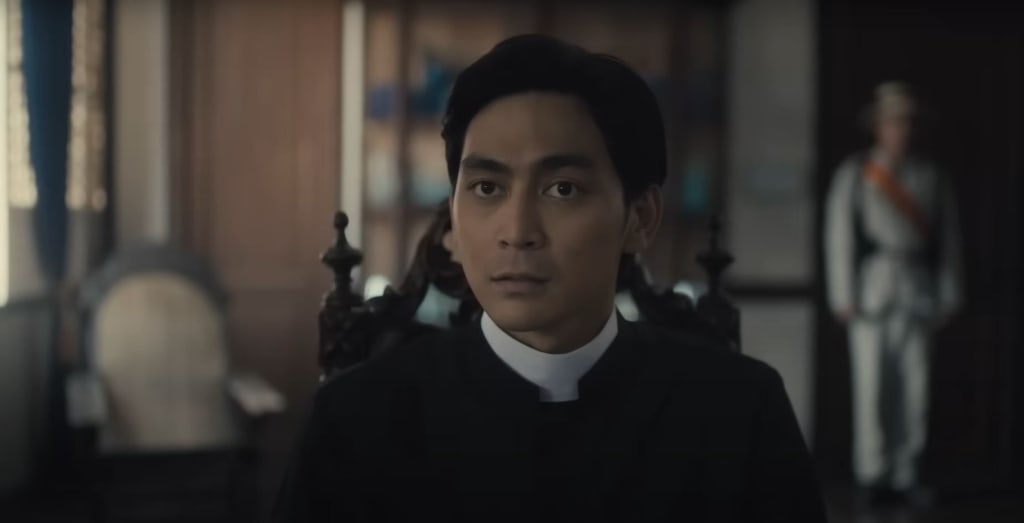GOMBURZA review: A satisfying and compelling story of Filipino Nationalism
Pepe Diokno's period drama gives honor to the precursors of the Filipino identity.

The tale of three Filipino priests, who gave way for the rise and development of the “Filipino” identity, and of the revolution itself is brought to life through Pepe Diokno’s film titled ‘GOMBURZA’, providing a detailed and lively portrayal of the lives of those prominent figures, bringing a very strong emphasis to the film’s nationalist theme.
Set in the mid-19th century and follows the journey of three Catholic priests: Mariano Gomez, Jose Burgos and Jacinto Zamora, as they are caught between the conflict between the rights native, secular clergy, and those of religious orders, whom are Spaniards. The conflict also coincides with the emergence of Filipino nationalism and the Cavite Mutiny, eventually leading to their trial and execution in Bagumbayan (now Rizal Park).
Although most of the historical events mentioned settled within 19th-century Manila, aside from the district of Intramuros, the film was also shot from various places outside Manila, like the Tayabas Basilica and the town of Taal, Batangas.
Producers of Jesuit Communications took the liberty to experiment with such scenes that would relate to historically accurate accounts to fill missing pieces in the story. Nevertheless, these scenes were carefully woven along with historical accurate events, creating an effective progress of events.
Prior to the main events, Diokno’s film tells a brief, but easily understandable story of a man named Hermano Pule, who created the Cofradia de San Jose as a response to the racial discrimination of Catholic Church clergy at the time towards Filipino natives, which sufficiently gives the audience a major hint of the film’s main conflict.
The film then introduces us to Padre Pedro Pelaez, played by Piolo Pascual, who is seen as a calm and collected figure in both thought and speech, showcased on his defense of the native priests’ right over their respective jurisdictions, as opposed to the takeover of the Spanish friars. Despite Pascual’s short appearance in the film, much due to the earthquake of 1863 that brought Fr. Pelaez’s demise, he captures well of his character and virtue as a priest in all his modesty and a critic without hesitation, but a hint of diplomacy was also present in his part.
Cedrick Juan plays the young and open-minded Fr. Jose Burgos, a close companion of Fr. Pelaez, enlightened and inspired by his senior’s ideas, without a doubt he eventually becomes the successor of Pelaez’s cause, that are integral for the development of the forthcoming events. Along with him is Fr. Mariano Gomez, played by Dante Rivero, also Fr. Burgos’ senior. Cedrick Juan’s portrayal, although careful and moderated, somehow manages to capture a few hints of youthfulness in his part. He relives the life of Fr. Burgos as optimistic and open-minded to the ideas of nationalism, along with his fellow secular priests are at the time. As a teacher at a university of his time, he was also able to influence his students, notably through Felipe Buencamino and Paciano Rizal, portrayed by Tommy Alejandrino and Elijah Canlas. An astounding and strong display of creative liberty that the producers took to show the emergence of the first instances of student activism.
As collected as Pascual’s character is in Juan’s portrayal of Fr. Burgos in many ways, there also lies an element of vigor present in him, effectively showing the amount of influence Fr. Pelaez has bestowed upon Fr. Burgos. Even at the portrayal of his execution, a sense of that vigor remains through his compelling act of final agony before being killed by strangulation along with his fellow clergy.
Rivero's portrayal on the other hand, relives the more conservative demeanor of Fr. Gomes than the former. As what could expect on a priest through his pastoral instincts. He who acts as an advisor in regard to Fr. Burgos’ prerogatives, even though sharing the same sentiments with him. One example of a scene, which he warns the way Fr. Burgos propagates his ideas to his students that led the way into the culmination of a student uprising. Pastoral even on the way to his execution, Rivero portrays very well that of a martyr’s death, humbled and accepted his fate.
On the other hand,, Enchong Dee’s portrayal of Fr. Jacinto Zamora, other than the kind of priest who would use “powder and munitions” as a slang term for ‘money’ to use on his gambling habit, and his fine performance of mental exhaustion and disorientation he felt the moment he was arrested and executed, it was all the actor could offer to the audience in getting to know the innocent cleric. He who has no knowledge of the predicaments of his own time, and was simply dragged upon within the conflict, no more no less.
One could say this historical drama would leave the audience well-contented, in contemplation, or in the height of intense emotion. Pepe Diokno’s GOMBURZA honors very well through its re-telling, a lasting legacy. A legacy which became the source of the nation’s eventual blossoming into national consciousness, like how it influenced the young Jose Rizal, it would continue to be refresh in the minds of generations to come.
About the Creator
Enjoyed the story? Support the Creator.
Subscribe for free to receive all their stories in your feed. You could also pledge your support or give them a one-off tip, letting them know you appreciate their work.





Comments
There are no comments for this story
Be the first to respond and start the conversation.